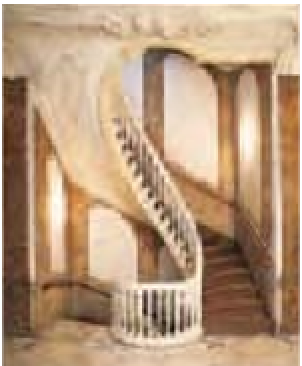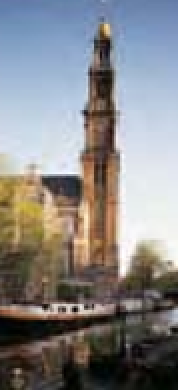Travel Reference
In-Depth Information
Anne Frankhuis
Recently enlarged, this
thought-provoking museum
encompasses the
achterhuis
,
secret hideout of Anne Frank and
her family, as well as background
information on the plight of
Amsterdam's Jews and racial
oppression
(see pp32-3)
.
Westerkerk
An exacting climb to the top
of the soaring tower of Wester-
kerk, a landmark close to the
heart of every Amsterdammer,
rewards you with a thrilling view
(see p67)
. Designed by Hendrick
de Keyser and completed in 1631,
its austere interior is unadorned,
except for the ornate organ and
its lively painted shutters. A
memorial to Rembrandt reminds
us that he was buried here,
although the precise burial site is
unknown. Outside the church,
notice the poignant, diminutive
statue of Anne Frank and
Homomonument, the
pink granite triangle
which commemorates
persecuted homo-
sexuals.
d
Prinsengracht
281. Map L2. 020 624 7766.
www.westerkerk.nl
•
Church:
open Apr-Sep: 11am-3pm
Mon-Fri (Aug-Sep also Sat).
Free
•
Tower: open Apr-Sep:
guided tours every hour from
10am-4pm Mon-Sat (check
first). Admission charge
Theatermuseum
Hendrick de Keyser in 1617 with
a contrastingly flamboyant
Renaissance façade, its curved
appearance cleverly reflecting
the canal bend on which it
stands. The frothy 18th-century
stuccoed and painted interior of
the White House is worth the
visit alone.
d
Herengracht 168
•
Map
L2
•
020 551 3300
•
www.tin.nl
•
Open
11am-5pm Mon-Fri, 1-5pm
Sat & Sun
•
Admission charge
Huis met de
Hoofden
An eye-catching
extravaganza, the
House with the Heads
is named for the six
heads on its elaborate
step-gabled façade
representing Classical
gods - Apollo, Ceres,
Mars, Minerva, Diana
and Bacchus. Built in
1622 for a successful
merchant, its Dutch
Renaissance design is
attributed to Hendrick de Keyser.
Today it is occupied by the body
in charge of Amsterdam's public
monuments. The ground floor has
scarcely changed.
d
Keizersgracht
123
•
Map L2
•
Closed to the public
except on
Monumentendagen (see p70)
Theatermuseum
Two fine buildings
house the Theater-
museum. Its entrance
is at No. 168, the austere Neo-
Classical White House designed
in 1638 by Philips Vingboons and
topped by Amsterdam's earliest
neck gable. The museum extends
into Nos 170-72, known as
Bartolotti House, designed by
Westerkerk
91










